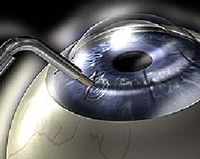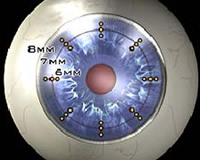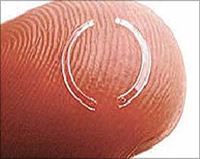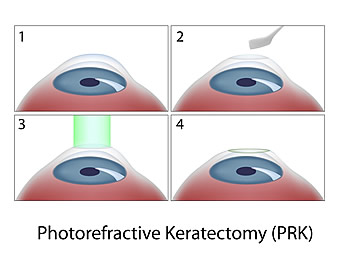LASIK Alternatives
LASIK may not be the best option for everyone. If Dr. Lin does not think LASIK is the answer to your specific circumstance, he will work with you to determine your best option. LASIK is only one of the many vision correction options you have at Pacific Eye Associates:
Glasses and/or Contact Lenses
At Pacific Eye Associates, we understand that surgical vision correction is not right for everyone. We offer many alternatives to laser vision correction, but the most common form of vision correction is through glasses and contacts! Patients who are considering LASIK eye surgery are generally already wearing either glasses or contacts lenses. Although they may seem like the technology of the past, glasses and contacts are often the best vision correction method for some of our patients. We encourage you to explore all of your options to be sure you are making the best decision for you and your sight.

Pacific Eye Associates boasts an excellent optical selection, you will feel peace of mind knowing our skilled opticians are there to help you with all of your glasses and contact lens needs. There are glasses and contacts lenses available that serve a variety of purposes and fit a variety of people. If you have any questions about our selection of glasses and contacts, or you would like to schedule an appointment to get them, please feel free to contact us!
Glasses and contact lenses are both equal in the way they improve vision, but they both have their advantages and disadvantages. Glasses, for instance, are easily removable and they are low maintenance. On the other side, glasses can get in the way of an active lifestyle. Contact lenses offer more freedom to be active without the worry of damaging glasses, but they are also more work to keep clean. Whichever you choose, make sure to first examine your lifestyle to figure out which would work best for you!
Conductive Keratoplasty (CK)
Conductive Keratoplasty (NearVision CK), FDA-approved for the treatment of presbyopia, is a vision correction option for individuals 40 years and older who have had good distance vision their entire life and now need to use eyeglasses for reading. NearVision CK is a refractive surgical procedure that uses radiofrequency energy to reshape the cornea. Inserting a small probe into the peripheral cornea, the doctor applies radiofrequency energy in concentric rings of multiple spots. The radiofrequency energy reshapes the corneal periphery without removing any tissue, causing the central part of the cornea to steepen to improve near vision. NearVision CK is performed on an outpatient basis with topical anesthesia. CK is also useful to treat low levels of hyperopia.

A radiofrequency probe gently heats focal spots in the peripheral cornea.

Different levels of treatment are available, depending upon the amount of near vision correction required based on age and pre-operative amount of farsightedness.
Intacs
Intracorneal Ring Implants (INTACS) are a vision correction option that was initially approved to treat low to moderate levels of myopia. INTACS are now used to correct myopia in patients who have keratoconus and those who have residual myopia following laser refractive surgery.
As with other procedures to correct myopia, INTACS are designed to alter the shape of the cornea. INTACS consist of two, tiny plastic half-rings that the doctor inserts through an opening near the outer edge of the cornea. The plastic half-rings rest between the layers of tissue outside the central optical zone of the cornea. This placement flattens the cornea, improving vision for those with myopia. The INTACS rest below the surface of the eye so they cannot be felt. They can be removed or changed to accommodate changing vision needs, if necessary.

INTACS consist of two micro-thin plastic half-rings.

INTACS are inserted into channels created near the edge of the cornea.
Limbal Relaxing Incision
Limbal Relaxing Incision (LRI) is a surgical technique used to treat astigmatism. The result is better vision without glasses or contact lenses. During surgery, tiny incisions are placed on the periphery of the cornea resulting in a cornea that is more rounded. The astigmatism is thus reduced and uncorrected vision improved. The procedure can be completed in a few seconds after numbing the eye with anesthetic drops. There is usually little if any post-operative discomfort. The procedure is very safe and is not associated with glare or starburst. The cornea is usually stable within a few weeks, indicating that visual fluctuations have typically resolved by that time.
Many patients who suffer from cataract also have to deal with astigmatism. Astigmatism prevents the patient from having a clear vision after the cataract has been removed from the eye. Having LRI performed while the cataract is being removed can help decrease or eliminate astigmatism and thus lead to better vision after cataract surgery. Small incisions are made on the corneal limbus using a diamond blade. The doctor will make the incision depending on the results of the corneal topographer. After the incisions have been made the shape of the cornea will be altered and help cure the blurred vision secondary to astigmatism.
Limbal relaxing incisions are strategically placed superficial incisions placed on the peripheral cornea, causing it to relax and become more spherical and round. This allows light to focus more precisely on the retina, causing vision to become sharper and clearer. Limbal relaxing incisions take minutes to perform and can be used alone or in conjunction with cataract surgery.
Multifocal Intraocular Lens (IOL)

Until recently, cataract patients received standard “monofocal” lens implants that had only a single focusing power. This meant you had a choice of correction for either far or near vision. If you suffer from presbyopia like many people over the age of 50, this would mean that you still need glasses for either reading or for distance vision.
The FDA has now approved several multifocal lens implants for use by certified ophthalmologists. The multifocal IOL lens can increase your chances for freedom from glasses for near, far, and intermediate vision. If you have worn glasses for many years, this might be an opportunity for you to eliminate this hassle from your life.
The FDA clinical results showed that 84% of patients who received the Alcon ReStor® lens in both eyes achieved distance visual acuity of 20/25 or better and near visual acuity of 20/32 or better without correction by contacts or glasses while only 23 percent of the conventional or monofocal control group achieved this level.
Clinical studies of the AMO Tecnis Multifocal Lens showed that nearly 9 out of 10 patients never wear glasses. Over 94% of patients would choose the Tecnis Multifocal Lens again.
Other lenses include the Bausch and Lomb Crystalens®. The Crystalens® features a hinged design that allows the lens to move forward as the eye attempts to focus on near objects, restoring some of the accommodative function in presbyopic patients.
PRK/ LASEK
Laser Epithelial Keratomileusis (LASEK), also called no-cut LASEK, is essentially LASIK without a corneal flap. With the eye under a local anesthetic, the doctor applies a diluted alcohol solution to the epithelium (the surface layer of the cornea), loosening it from the stroma (the tissue beneath). The loosened epithelium is placed to one side and laser energy is applied to the stroma, using the same parameters to reshape the cornea as in LASIK surgery. After the completion of the laser treatment, the epithelium is repositioned. A contact lens is placed on the cornea for several days to aid in healing and comfort. During the few days required for healing, the eyes can be sensitive to light and uncomfortable.
Photo-Refractive Keratectomy (PRK) is another method of surgically reshaping the cornea using the excimer laser. The primary difference between PRK and LASEK is that for PRK, the surface epithelium is removed entirely in the area of treatment, whereas in LASEK, the epithelium is pushed to the side after being loosened with alcohol and repositioned after laser treatment. In both procedures, healthy corneal cells grow over the treatment zone from the periphery of the cornea. A contact lens is applied after surgery to improve comfort. During the few days required for healing, the eyes can be sensitive to light and uncomfortable.

Refractive Lens Exchange
Refractive lens exchange (RLE) is a surgical procedure to correct refractive error. It differs from laser vision correction because it involves replacing the natural lens of the eye with an intraocular lens. RLE is similar to cataract surgery. The corrective power and the type of IOL can be selected based on the individual’s lifestyle needs.
AcrySof Toric IOL
The AcrySof Toric (astigmatism-reducing) lens is a foldable lens that an eye surgeon implants during cataract surgery to replace the clouded lens. The unique design of the Acrysof Toric IOL makes it possible to eliminate or reduce corneal astigmatism and significantly improve uncorrected distance vision.


